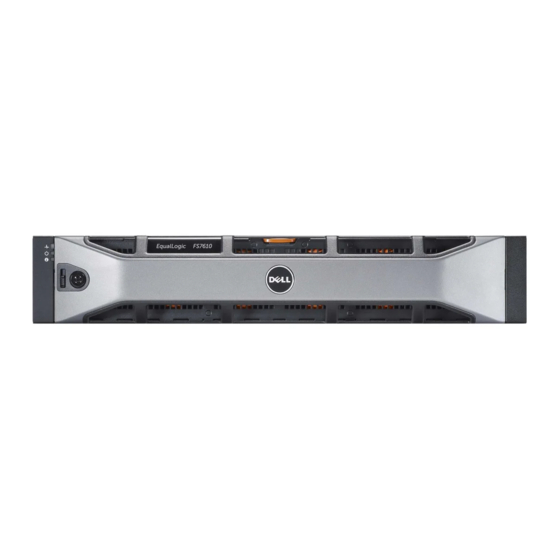Dell EqualLogic FS7610 Installatie- en installatiehandleiding - Pagina 37
Blader online of download pdf Installatie- en installatiehandleiding voor {categorie_naam} Dell EqualLogic FS7610. Dell EqualLogic FS7610 46 pagina's. Appliances
Ook voor Dell EqualLogic FS7610: Overzicht (7 pagina's), Hardware Gebruikershandleiding (32 pagina's)

Dell EqualLogic FS7610 Installation and Setup Guide
All three options allow access to the other types. However, the Mixed type changes the permission based on the
assigned permissions of the last user who accessed the share. Therefore, the Mixed type is not recommended in
environments where share access needs to be controlled.
Microsoft Active Directory and UNIX/Linux POSIX permissions are different, and cannot be accurately related
to each other. Determine whether your environment is predominantly Microsoft or Linux, then decide on a share
type that allows the best access control with the least management effort.
For example, if your environment chiefly has Microsoft clients, define the shares as NTFS. Active Directory
permissions will be applied by user name regardless of whether the client is actually Linux or Microsoft.
Conversely, the permissions used in a predominantly Linux/POSIX environment will be POSIX-based by either
an LDAP or NIS server.
Transferring Share Ownership
When you create a CIFS share, it is initially owned by the CIFS administrator. This built-in account has a
randomly generated password for security purposes. From the Group Manager GUI where you logged in as the
default Group Manager administrator (the
password before attempting to access the CIFS share from a client system.
To change the CIFS administrator password, see the Dell EqualLogic Group Manager Administrator's Manual.
From a Windows client system, log in to the CIFS share using the new CIFS administrator password and assign
or share read-write permissions to individual users or groups.
You can also perform this operation using the Domain Administrator account, if the NAS cluster is part of an
Active Directory domain. Only the CIFS administrator or the domain administrator can set the permissions for
other local users and groups, or domain users and groups.
Accessing a CIFS Share
For a user to have access to a CIFS share, the following conditions must be met:
•
The user must be a valid user and provide a valid password (local or remote authentication).
•
The group administrator must set the CIFS administrator password.
•
An administrator must log in to the share using the CIFS administrator account (DOMAIN\ADMIN) and
password and use the normal Windows operating system process to assign the user write permission to the
share.
If the last two conditions are not met, a user can access the CIFS share but cannot write to it.
To access a CIFS share from a Windows system, follow the steps for your Windows version. For example, to
access a CIFS share from a system running Windows Server 2008 R2:
1. Click
, then click
Start
2. Specify the NAS Cluster IP address in the
3. In the Windows security dialog box, enter
then click OK.
grpadmin
.
Run
Open field and share name
_ip_address\share_name
account), you must change the CIFS administrator's
and your CIFS administrator password,
6 NAS Storage Allocation
and click
.
OK
31
